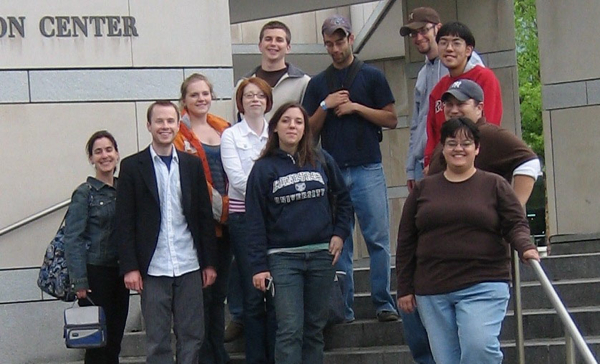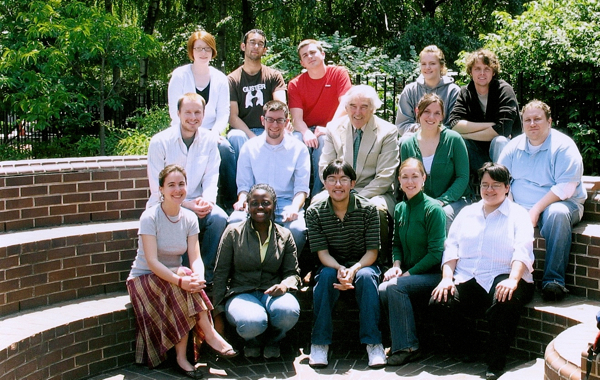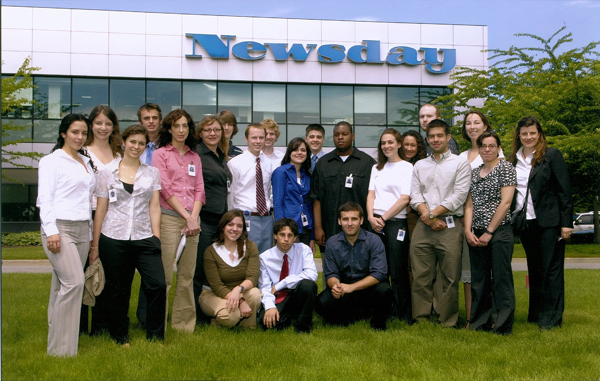
This photo was taken during the 2007 Temple residency participants' half-day in the city of Philadelphia. For most of the two weeks, we were confined to a cold classroom with a tough editing teacher. But we at least enjoyed one afternoon at the National Constitution Center, above. Can't you tell we're tired?

A portrait of all the suspects, including professor Ed Trayes in the center.
Update: Version on the DJNF blog here.
Just more than a year ago, my parents got a telephone call that would change my journalism career.
I was in a master's-level class at American University in Washington, and Mom and Dad were 800 miles away in my hometown of Princeton, Maine.
Mom talked to some man named Ed Trayes, and he wanted my phone number. I had ditched my old Maine number after living in D.C. for a while. Trayes said in a later e-mail, "Apparently you terminated that number and it is now being used by someone else in Maine who is really looking forward to a *big snow* that is supposed to roll in sometime today."
Trayes had something really important to tell me. Reluctantly, Mom gave in.
She did the right thing.
Trayes isn't some creepy guy who likes to call parents and ask them for their child's number. He's the co-founder of the Dow Jones Newspaper Fund, which, through an essay and a test, selects undergraduate and graduate students for copy editing internships at top newspapers nationwide.
Trayes had an offer I would have been foolish to refuse: an internship at Newsday.
Of course, I was overjoyed, but I didn't know what I was getting into.
 The editing internship first requires a two-week residency at Temple University in Philadelphia, where Trayes, a professor there, drilled into me and the other interns each entry of the Associated Press Stylebook, along with all of the countries and their capitals, among many, many other bits of knowledge that are essential to copy editing. We learned the difference between "founder" (to sink) and "flounder" (a fish, left, in Philly's Reading Terminal Market.)
The editing internship first requires a two-week residency at Temple University in Philadelphia, where Trayes, a professor there, drilled into me and the other interns each entry of the Associated Press Stylebook, along with all of the countries and their capitals, among many, many other bits of knowledge that are essential to copy editing. We learned the difference between "founder" (to sink) and "flounder" (a fish, left, in Philly's Reading Terminal Market.)It was the most difficult, exhausting and rewarding two-week boot camp I have been subjected to. Most of our time was spent in the classroom, and the rest was spent studying. Three hours of sleep was a good night. We weren't given specific grades for our work and none of us failed out of the course. Nevertheless, all interns tirelessly gave their all as if their lives depended on it. I've never treated a final exam with more importance than I did each stylebook quiz or geography test that Trayes administered.
A blog at http://djnf08.wordpress.com/ has compiled the experiences - including that exhaustion factor - of Trayes' current batch of interns. There's a great variety. Some posts detail what the interns learned at Temple. Others address the interns' impressions of the cities where they are working this summer as copy editors.
As for me, when I left Temple, I was confident and ready for the task at Newsday.
As an intern, I wasn't pigeonholed into menial tasks. I was given important stories with many stones. Under each stone, there was something lurking that shouldn't have been there. I left none unturned.
It was at Newsday that I learned the need to relentlessly question reporters' writing and other editors' editing. Even if I wasn't sure of a question, I asked it. There truly is no such thing as a stupid question in copy editing because you never know the answer. Chances are good that the answer will be even more ridiculous than the question itself.
The most challenging story I have ever edited was one written by Pulitzer Prize-winning columnist Jimmy Breslin. One of a copy editor's best qualities is to challenge authority. I questioned nearly every sentence - and its punctuation marks - in Breslin's column. The metro editor responded: "Breslin has been a journalist for decades. He has a voice. We cannot take that from him." But at least I was able to sleep that night because I did my job: I asked the questions.
 My favorite "catch" - as copy editors call the zapping of errors - came minutes before deadline when I simply opened my eyes. An Associated Press caption said military members in a photo were Marines. But I looked at the patches on their uniforms, and they said "U.S. Army." The next day, the error didn't show up in Newsday - but it did appear on the front page of The New York Times (accompanying image is of the correction).
My favorite "catch" - as copy editors call the zapping of errors - came minutes before deadline when I simply opened my eyes. An Associated Press caption said military members in a photo were Marines. But I looked at the patches on their uniforms, and they said "U.S. Army." The next day, the error didn't show up in Newsday - but it did appear on the front page of The New York Times (accompanying image is of the correction).It's unfortunate that I was likely the last Dow Jones intern Newsday will ever have. The paper eliminated its internship program and its two Dow Jones positions after I left. I heard that the Dow Jones spots were transferred to The Wall Street Journal; at least they weren't lost this year.
Now, as a copy editor at FLORIDA TODAY, I owe a great deal of the success of my early career and the way it took shape to the Dow Jones program and to Trayes' teaching - and of course, to my mother. I'm not sure whom to thank more: Trayes for offering me an internship or Mom for picking up the phone.

At the beginning of their stints, the Newsday interns of summer 2007 pose for a photo in front of the newspaper's Melville, N.Y., headquarters. I'm standing just left of center in the red tie, white shirt and blue pants. The young lady kneeling is Allison Morrow, the other copy editing intern who also attended the Dow Jones residency at Temple University. The guy kneeling next to her is Sam Rubenfeld of Hofstra University, who is a Dow Jones intern this summer at Dow Jones Newswires. Great back-to-back summers for him. And directly beneath the intersection of the W and S in the Newsday sign is Tim Robertson, with whom I interned at the Bangor Daily News in Maine.



No comments:
Post a Comment